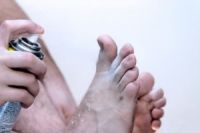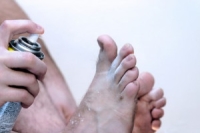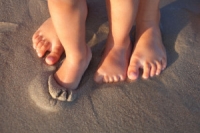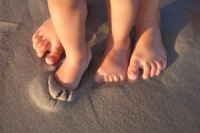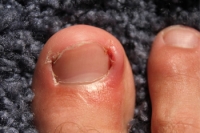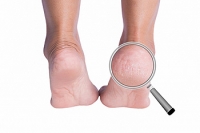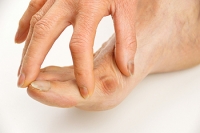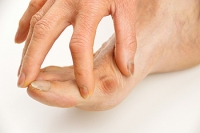
Blog (826)
Why Does Athlete’s Foot Occur?
The condition that is referred to as athlete’s foot is known to be a contagious fungal infection. It may typically occur as a result of fungus entering the feet through tiny cracks in the skin. A perfect environment for this type of fungus to thrive in are warm and moist areas, which may include the inside of shoes and socks. It most commonly affects the space between the toes, and noticeable symptoms may include severe itching and redness, in addition to the skin becoming cracked, which may be painful. It is typically spread by walking barefoot in public pools and surrounding areas, including locker rooms and shower stalls. There may be some patients who have specific medical conditions that may encourage athlete’s foot to develop easier. These may include poor blood circulation, dermatitis, or a genetic trait. If you have any of the symptoms that are associated with athlete’s foot, it is advised to speak to a podiatrist who can properly assist you in choosing the correct treatment.
Athlete’s foot is an inconvenient condition that can be easily reduced with the proper treatment. If you have any concerns about your feet and ankles, contact Dr. Kenneth Donovan from Advanced Care Foot and Ankle.
Our doctor will treat your foot and ankle needs.
Athlete’s Foot: The Sole Story
Athlete's foot, also known as tinea pedis, can be an extremely contagious foot infection. It is commonly contracted in public changing areas and bathrooms, dormitory style living quarters, around locker rooms and public swimming pools, or anywhere your feet often come into contact with other people.
Solutions to Combat Athlete’s Foot
- Hydrate your feet by using lotion
- Exfoliate
- Buff off nails
- Use of anti-fungal products
- Examine your feet and visit your doctor if any suspicious blisters or cuts develop
Athlete’s foot can cause many irritating symptoms such as dry and flaking skin, itching, and redness. Some more severe symptoms can include bleeding and cracked skin, intense itching and burning, and even pain when walking. In the worst cases, Athlete’s foot can cause blistering as well. Speak to your podiatrist for a better understanding of the different causes of Athlete’s foot, as well as help in determining which treatment options are best for you.
If you have any questions please feel free to contact one of our offices located in Warren, Livingston, and Toms River, NJ . We offer the newest diagnostic and treatment technologies for all your foot and ankle needs.
Why Does Athlete’s Foot Occur?
 The condition that is referred to as athlete’s foot is known to be a contagious fungal infection. It may typically occur as a result of fungus entering the feet through tiny cracks in the skin. A perfect environment for this type of fungus to thrive in are warm and moist areas, which may include the inside of shoes and socks. It most commonly affects the space between the toes, and noticeable symptoms may include severe itching and redness, in addition to the skin becoming cracked, which may be painful. It is typically spread by walking barefoot in public pools and surrounding areas, including locker rooms and shower stalls. There may be some patients who have specific medical conditions that may encourage athlete’s foot to develop easier. These may include poor blood circulation, dermatitis, or a genetic trait. If you have any of the symptoms that are associated with athlete’s foot, it is advised to speak to a podiatrist who can properly assist you in choosing the correct treatment.
The condition that is referred to as athlete’s foot is known to be a contagious fungal infection. It may typically occur as a result of fungus entering the feet through tiny cracks in the skin. A perfect environment for this type of fungus to thrive in are warm and moist areas, which may include the inside of shoes and socks. It most commonly affects the space between the toes, and noticeable symptoms may include severe itching and redness, in addition to the skin becoming cracked, which may be painful. It is typically spread by walking barefoot in public pools and surrounding areas, including locker rooms and shower stalls. There may be some patients who have specific medical conditions that may encourage athlete’s foot to develop easier. These may include poor blood circulation, dermatitis, or a genetic trait. If you have any of the symptoms that are associated with athlete’s foot, it is advised to speak to a podiatrist who can properly assist you in choosing the correct treatment.
Athlete’s foot is an inconvenient condition that can be easily reduced with the proper treatment. If you have any concerns about your feet and ankles, contact Dr. Kenneth Donovan from Advanced Care Foot and Ankle. Our doctor will treat your foot and ankle needs.
Athlete’s Foot: The Sole Story
Athlete's foot, also known as tinea pedis, can be an extremely contagious foot infection. It is commonly contracted in public changing areas and bathrooms, dormitory style living quarters, around locker rooms and public swimming pools, or anywhere your feet often come into contact with other people.
Solutions to Combat Athlete’s Foot
- Hydrate your feet by using lotion
- Exfoliate
- Buff off nails
- Use of anti-fungal products
- Examine your feet and visit your doctor if any suspicious blisters or cuts develop
Athlete’s foot can cause many irritating symptoms such as dry and flaking skin, itching, and redness. Some more severe symptoms can include bleeding and cracked skin, intense itching and burning, and even pain when walking. In the worst cases, Athlete’s foot can cause blistering as well. Speak to your podiatrist for a better understanding of the different causes of Athlete’s foot, as well as help in determining which treatment options are best for you.
If you have any questions please feel free to contact one of our offices located in Warren, Livingston, and Toms River, NJ . We offer the newest diagnostic and treatment technologies for all your foot and ankle needs.
Try Soft Soled Shoes for Baby’s First Shoe
Research has shown that a baby’s foot is generally flexible and padded with fatty tissue until walking begins. Babies will typically begin walking at approximately 12 months of age and many toddlers are flat footed. This condition will generally disappear once walking has begun, and this may be a result of the increased strength of bones and muscles that are present in the feet. When the walking process starts, a soft soled shoe is ideal to begin wearing and this may enable the toddler to feel the ground while walking, in addition to protecting their feet. The correct shoe size may be determined by measuring your child’s feet frequently and this may aid in monitoring the speed of their growing feet. Please make sure there is plenty of room for the toes to move freely in, in addition to confirming the shoe is comfortable in width and length. It is suggested to consult with a podiatrist if you would like additional information about how to take care of children’s feet.
The health of a child’s feet is vital to their overall well-being. If you have any questions regarding foot health, contact Dr. Kenneth Donovan of Advanced Care Foot and Ankle. Our doctor can provide the care you need to keep you pain-free and on your feet.
Tips for Keeping Children's Feet Healthy
- Make sure their shoes fit properly
- Look for any signs of in-toeing or out-toeing
- Check to see if they have Clubfoot (condition that affects your child’s foot and ankle, twisting the heel and toes inward) which is one of the most common nonmajor birth defects.
- Lightly cover your baby’s feet (Tight covers may keep your baby from moving their feet freely, and could prevent normal development)
- Allow your toddler to go shoeless (Shoes can be restricting for a young child’s foot)
- Cut toenails straight across to avoid ingrown toenails
- Keep your child’s foot clean and dry
- Cover cuts and scrapes. Wash any scratches with soap and water and cover them with a bandage until they’ve healed.
If you have any questions, please feel free to contact one of our offices located in Warren, Livingston, and Toms River, NJ . We offer the newest diagnostic and treatment technologies for all your foot care needs.
Try Soft Soled Shoes for Baby's First Shoe
 Research has shown that a baby’s foot is generally flexible and padded with fatty tissue until walking begins. Babies will typically begin walking at approximately 12 months of age and many toddlers are flat footed. This condition will generally disappear once walking has begun, and this may be a result of the increased strength of bones and muscles that are present in the feet. When the walking process starts, a soft soled shoe is ideal to begin wearing and this may enable the toddler to feel the ground while walking, in addition to protecting their feet. The correct shoe size may be determined by measuring your child’s feet frequently and this may aid in monitoring the speed of their growing feet. Please make sure there is plenty of room for the toes to move freely in, in addition to confirming the shoe is comfortable in width and length. It is suggested to consult with a podiatrist if you would like additional information about how to take care of children’s feet.
Research has shown that a baby’s foot is generally flexible and padded with fatty tissue until walking begins. Babies will typically begin walking at approximately 12 months of age and many toddlers are flat footed. This condition will generally disappear once walking has begun, and this may be a result of the increased strength of bones and muscles that are present in the feet. When the walking process starts, a soft soled shoe is ideal to begin wearing and this may enable the toddler to feel the ground while walking, in addition to protecting their feet. The correct shoe size may be determined by measuring your child’s feet frequently and this may aid in monitoring the speed of their growing feet. Please make sure there is plenty of room for the toes to move freely in, in addition to confirming the shoe is comfortable in width and length. It is suggested to consult with a podiatrist if you would like additional information about how to take care of children’s feet.
The health of a child’s feet is vital to their overall well-being. If you have any questions regarding foot health, contact Dr. Kenneth Donovan of Advanced Care Foot and Ankle. Our doctor can provide the care you need to keep you pain-free and on your feet.
Tips for Keeping Children's Feet Healthy
- Make sure their shoes fit properly
- Look for any signs of in-toeing or out-toeing
- Check to see if they have Clubfoot (condition that affects your child’s foot and ankle, twisting the heel and toes inward) which is one of the most common nonmajor birth defects.
- Lightly cover your baby’s feet (Tight covers may keep your baby from moving their feet freely, and could prevent normal development)
- Allow your toddler to go shoeless (Shoes can be restricting for a young child’s foot)
- Cut toenails straight across to avoid ingrown toenails
- Keep your child’s foot clean and dry
- Cover cuts and scrapes. Wash any scratches with soap and water and cover them with a bandage until they’ve healed.
If you have any questions, please feel free to contact one of our offices located in Warren, Livingston, and Toms River, NJ . We offer the newest diagnostic and treatment technologies for all your foot care needs.
Symptoms of an Ingrown Toenail
The definition of an ingrown toenail is described as the toenail growing into a portion of the skin on either side of the nail. This condition may cause little discomfort in the early stages of development and may worsen as time progresses. Swelling, redness, or a possible infection may occur as a result of the nail piercing the skin, and this may lead to an infection. The body’s natural response for healing is to have a specific type of skin that may grow at the site of the infection, which is known as hypergranulation. This will generally dissolve once treatment has begun and the infection dissipates. There are several causes for this ailment to occur, and these may include wearing poorly fitting shoes or socks, having a family history of ingrown toenails, or improperly trimming the toenails. If you feel you have developed this uncomfortable condition, it is suggested to seek the advice of a podiatrist who can properly assist in the correct treatment.
Ingrown toenails may initially present themselves as a minor discomfort, but they may progress into an infection in the skin without proper treatment. For more information about ingrown toenails, contact Dr. Kenneth Donovan of Advanced Care Foot and Ankle. Our doctor can provide the care you need to keep you pain-free and on your feet.
Ingrown Toenails
Ingrown toenails are caused when the corner or side of a toenail grows into the soft flesh surrounding it. They often result in redness, swelling, pain, and in some cases, infection. This condition typically affects the big toe and may recur if it is not treated properly.
Causes
- Improper toenail trimming
- Genetics
- Improper shoe fitting
- Injury from pedicures or nail picking
- Abnormal gait
- Poor hygiene
You are more likely to develop an ingrown toenail if you are obese, have diabetes, arthritis, or have any fungal infection in your nails. Additionally, people who have foot or toe deformities are at a higher risk of developing an ingrown toenail.
Symptoms
Some symptoms of ingrown toenails are redness, swelling, and pain. In rare cases, there may be a yellowish drainage coming from the nail.
Treatment
Ignoring an ingrown toenail can have serious complications. Infections of the nail border can progress to a deeper soft-tissue infection, which can then turn into a bone infection. You should always speak with your podiatrist if you suspect you have an ingrown toenail, especially if you have diabetes or poor circulation.
If you have any questions, please feel free to contact one of our offices located in Warren, Livingston, and Toms River, NJ . We offer the newest diagnostic and treatment technologies for all your foot care needs.
Is Obesity Connected to Plantar Fasciitis?
Research has shown there are several uncomfortable foot conditions that may develop as a result of being overweight. The excess weight may put additional pressure on the plantar fascia, which is the tissue that connects the heel to the toes. If this tissue should become torn or inflamed, the condition that is known as plantar fasciitis may develop. It is known to cause severe pain and discomfort and the ability to perform daily activities may be compromised. The pain is typically felt in the heel and surrounding areas and wearing custom-made orthotics may provide a moderate level of relief. Patients who are obese may have trouble in practicing a routine exercise regime, and this may be a result of the inability to move freely, often caused by uncomfortable heel pain. If you have any form of heel pain, it is suggested to speak to a podiatrist who can properly guide you to correct treatment options.
Obesity has become very problematic at this point in time and can have extremely negative effects on the feet. If you’re an obese individual and are concerned about your feet, contact Dr. Kenneth Donovan from Advanced Care Foot and Ankle. Our doctor can provide the care you need to keep you pain-free and on your feet.
Obesity and Your Feet
Since your feet are what support your entire weight when standing, any additional weight can result in pain and swelling. Being overweight is one of the main contributors to foot complications.
Problems & Complications
Extra Weight – Even putting on just a few extra pounds could create serious complications for your feet. As your weight increases, your balance and body will shift, creating new stresses on your feet. This uneven weight distribution can cause pain, even while doing the simplest tasks, such as walking.
Diabetes – People who are overweight are at serious risk of developing type-2 diabetes, which has a drastic impact on the health of your feet. As you get older, your diabetes might worsen, which could lead to loss of feeling in your feet, sores, and bruises. You could also become more prone to various infections.
Plantar fasciitis – Pressure and stress that is placed on muscles, joints, and tendons can trigger plantar fasciitis, which is an inflammation of tissue that forms along the bottom of the foot.
If you have any questions please feel free to contact one of our offices located in Warren, Livingston, and Toms River, NJ . We offer the newest diagnostic and treatment technologies for all your foot and ankle needs.
Is Obesity Connected to Plantar Fasciitis?
 Research has shown there are several uncomfortable foot conditions that may develop as a result of being overweight. The excess weight may put additional pressure on the plantar fascia, which is the tissue that connects the heel to the toes. If this tissue should become torn or inflamed, the condition that is known as plantar fasciitis may develop. It is known to cause severe pain and discomfort and the ability to perform daily activities may be compromised. The pain is typically felt in the heel and surrounding areas and wearing custom-made orthotics may provide a moderate level of relief. Patients who are obese may have trouble in practicing a routine exercise regime, and this may be a result of the inability to move freely, often caused by uncomfortable heel pain. If you have any form of heel pain, it is suggested to speak to a podiatrist who can properly guide you to correct treatment options.
Research has shown there are several uncomfortable foot conditions that may develop as a result of being overweight. The excess weight may put additional pressure on the plantar fascia, which is the tissue that connects the heel to the toes. If this tissue should become torn or inflamed, the condition that is known as plantar fasciitis may develop. It is known to cause severe pain and discomfort and the ability to perform daily activities may be compromised. The pain is typically felt in the heel and surrounding areas and wearing custom-made orthotics may provide a moderate level of relief. Patients who are obese may have trouble in practicing a routine exercise regime, and this may be a result of the inability to move freely, often caused by uncomfortable heel pain. If you have any form of heel pain, it is suggested to speak to a podiatrist who can properly guide you to correct treatment options.
Obesity has become very problematic at this point in time and can have extremely negative effects on the feet. If you’re an obese individual and are concerned about your feet, contact Dr. Kenneth Donovan from Advanced Care Foot and Ankle. Our doctor can provide the care you need to keep you pain-free and on your feet.
Obesity and Your Feet
Since your feet are what support your entire weight when standing, any additional weight can result in pain and swelling. Being overweight is one of the main contributors to foot complications.
Problems & Complications
Extra Weight – Even putting on just a few extra pounds could create serious complications for your feet. As your weight increases, your balance and body will shift, creating new stresses on your feet. This uneven weight distribution can cause pain, even while doing the simplest tasks, such as walking.
Diabetes – People who are overweight are at serious risk of developing type-2 diabetes, which has a drastic impact on the health of your feet. As you get older, your diabetes might worsen, which could lead to loss of feeling in your feet, sores, and bruises. You could also become more prone to various infections.
Plantar fasciitis – Pressure and stress that is placed on muscles, joints, and tendons can trigger plantar fasciitis, which is an inflammation of tissue that forms along the bottom of the foot.
If you have any questions please feel free to contact one of our offices located in Warren, Livingston, and Toms River, NJ . We offer the newest diagnostic and treatment technologies for all your foot and ankle needs.
Possible Causes of Cracked Heels
If you suffer from cracked heels, you may be familiar with the pain and discomfort that is often associated with this condition. There are several reasons linked to developing cracked heels, including a loss of moisture in the skin as the aging process occurs, and medical conditions that may include thyroid issues and vitamin deficiencies. Additionally, people who are obese may suffer from this condition and this may be a result of the excess weight the heels must endure. Research has shown the importance of wearing shoes that offer maximum support in the heel area, which may diminish the possibility of developing this painful condition. There may be measures that can be implemented to prevent this ailment from occurring, which may include washing and drying the feet thoroughly, followed by utilizing a good moisturizing cream. If you have cracked heels, it is suggested to speak to a podiatrist to discuss additional treatment options.
If the skin on your feet starts to crack, you may want to see a podiatrist to find treatment. If you have any concerns, contact Dr. Kenneth Donovan from Advanced Care Foot and Ankle. Our doctor can provide the care you need to keep you pain-free and on your feet.
Cracked Heels
It is important to moisturize your cracked heels in order to prevent pain, bleeding, and infection. The reason cracked heels form is because the skin on the foot is too dry to support the immense pressure placed on them. When the foot expands, the dry skin on the foot begins to split.
Ways to Help Heal Them
- Invest in a good foot cream
- Try Using Petroleum Jelly
- Ease up on Soaps
- Drink Plenty of Water
Ways to Prevent Cracked Heels
- Moisturize After Showering
- Skip a Shower
- Keep Shower Water Lukewarm
- Don’t Scrub Your Feet
If you are unsure how to proceed in treating cracked heels, seek guidance from a podiatrist.
Your doctor will help you with any questions or information you may need.
If you have any questions, please feel free to contact one of our offices located in Warren, Livingston, and Toms River, NJ. We offer the newest diagnostic and treatment technologies for all your foot care needs.
Corns and Bunions May Produce Foot Pain
There are many types of foot conditions that may cause considerable pain and discomfort, which can lead to limited mobility. The foot is comprised of several bones, tendons and ligaments and if any one of these should endure an injury, the overall function of the body may be compromised. There are several types of foot pain most of the population may experience at some point in their lives. These may include having a corn develop, which is a small and yellowish area that generally forms on the top of the toes. This is typically the result of wearing shoes that fit incorrectly. Additionally, a bony protrusion that forms on the side of the big toe is referred to as a bunion and may develop from having arthritis or wearing improper footwear. If a fall has occurred, spraining or breaking the ankle may be a painful consequence. If you are experiencing any type of foot pain, it is advised to seek the counsel of a podiatrist who can properly treat these conditions.
Foot Pain
Foot pain can be extremely painful and debilitating. If you have a foot pain, consult with Dr. Kenneth Donovan from Advanced Care Foot and Ankle. Our doctor will assess your condition and provide you with quality foot and ankle treatment.
Causes
Foot pain is a very broad condition that could be caused by one or more ailments. The most common include:
- Bunions
- Hammertoes
- Plantar Fasciitis
- Bone Spurs
- Corns
- Tarsal Tunnel Syndrome
- Ingrown Toenails
- Arthritis (such as Gout, Rheumatoid, and Osteoarthritis)
- Flat Feet
- Injury (from stress fractures, broken toe, foot, ankle, Achilles tendon ruptures, and sprains)
- And more
Diagnosis
To figure out the cause of foot pain, podiatrists utilize several different methods. This can range from simple visual inspections and sensation tests to X-rays and MRI scans. Prior medical history, family medical history, and any recent physical traumatic events will all be taken into consideration for a proper diagnosis.
Treatment
Treatment depends upon the cause of the foot pain. Whether it is resting, staying off the foot, or having surgery; podiatrists have a number of treatment options available for foot pain.
If you have any questions, please feel free to contact one of our offices located in Warren, Livingston, and Toms River, NJ . We offer the newest diagnostic and treatment technologies for all your foot care needs.
Corns and Bunions May Produce Foot Pain
 There are many types of foot conditions that may cause considerable pain and discomfort, which can lead to limited mobility. The foot is comprised of several bones, tendons and ligaments and if any one of these should endure an injury, the overall function of the body may be compromised. There are several types of foot pain most of the population may experience at some point in their lives. These may include having a corn develop, which is a small and yellowish area that generally forms on the top of the toes. This is typically the result of wearing shoes that fit incorrectly. Additionally, a bony protrusion that forms on the side of the big toe is referred to as a bunion and may develop from having arthritis or wearing improper footwear. If a fall has occurred, spraining or breaking the ankle may be a painful consequence. If you are experiencing any type of foot pain, it is advised to seek the counsel of a podiatrist who can properly treat these conditions.
There are many types of foot conditions that may cause considerable pain and discomfort, which can lead to limited mobility. The foot is comprised of several bones, tendons and ligaments and if any one of these should endure an injury, the overall function of the body may be compromised. There are several types of foot pain most of the population may experience at some point in their lives. These may include having a corn develop, which is a small and yellowish area that generally forms on the top of the toes. This is typically the result of wearing shoes that fit incorrectly. Additionally, a bony protrusion that forms on the side of the big toe is referred to as a bunion and may develop from having arthritis or wearing improper footwear. If a fall has occurred, spraining or breaking the ankle may be a painful consequence. If you are experiencing any type of foot pain, it is advised to seek the counsel of a podiatrist who can properly treat these conditions.
Foot Pain
Foot pain can be extremely painful and debilitating. If you have a foot pain, consult with Dr. Kenneth Donovan from Advanced Care Foot and Ankle. Our doctor will assess your condition and provide you with quality foot and ankle treatment.
Causes
Foot pain is a very broad condition that could be caused by one or more ailments. The most common include:
- Bunions
- Hammertoes
- Plantar Fasciitis
- Bone Spurs
- Corns
- Tarsal Tunnel Syndrome
- Ingrown Toenails
- Arthritis (such as Gout, Rheumatoid, and Osteoarthritis)
- Flat Feet
- Injury (from stress fractures, broken toe, foot, ankle, Achilles tendon ruptures, and sprains)
- And more
Diagnosis
To figure out the cause of foot pain, podiatrists utilize several different methods. This can range from simple visual inspections and sensation tests to X-rays and MRI scans. Prior medical history, family medical history, and any recent physical traumatic events will all be taken into consideration for a proper diagnosis.
Treatment
Treatment depends upon the cause of the foot pain. Whether it is resting, staying off the foot, or having surgery; podiatrists have a number of treatment options available for foot pain.
If you have any questions, please feel free to contact one of our offices located in Warren, Livingston, and Toms River, NJ . We offer the newest diagnostic and treatment technologies for all your foot care needs.
Read more about Foot Pain